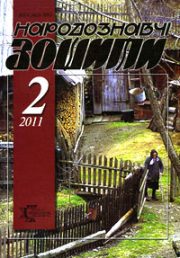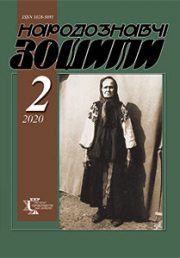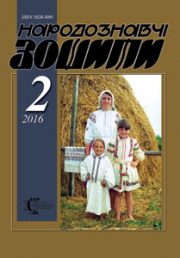The Ethnology Notebooks. 2020. № 3 (153), 614—621
UDK 27+398(477)”7.046″
DOI https://doi.org/10.15407/nz2020.03.614
HOLY SPYRIDON THE TRIMYPHUS : THE CYPRUS SAINT IN UKRAINIAN SPIRITUAL CULTURE
KULISH Oksana
ORCID ID: https://orcid.org/0000-0002-9625-0690
Candidate of Sciences in Art Studies (Ph. D),
Lecturer of Cherkasy Professional College
of Food Technology and Business,
84, Smilyanska st., 18008, Cherkasy, Ukraine,
Contacts: e-mail: kulish_oxana_andre@ukr.net
Abstract. St. Spyridon the Trimyphus — a prominent figure in the history of the Church of the early Christian period. The object of the research is Ukrainian spiritual culture, the value of which is enhanced by the fact that the figure of St. Spyridon (the subject of research) has a prominent place in Ukrainian folklore, sacred art and architecture. The topicality of the coverage of the significance of the Ukrainian spiritual culture in the world complex of Christian culture relates to the essence of the problem of research — the Russian imperial narrative which even today, in the information space, in particular, on the Internet continues the tendency of assigning prominent representatives of Ukrainian culture as Orthodox Russian pilgrims to the place of worship of this Cypriot saint. The purpose of the research is establishing of the fact of the presence of St. Spyridon in the Ukrainian spiritual culture in the dimension of the present post-industrial society and previous industrial, traditional societies based on examples of Ukrainian folklore and Christian culture, such as: temple building, monumental art, pilgrimage, veneration of the icons and relics of St. Spyridon the Trimyphus. The methodological basis of the work is the historical, descriptive and artistic aspects applied in ethnographic and religious-cultural contexts, as well as the original postulate of this article on the expediency of a divine narrative in the Christian faith.
As a result, the spiritual connection of Cypriot the Wonderworker Spyridon, a world-class saint, with the Ukrainian people, as a baptized community by the Byzantine rite, began with oral folk art. In our post-industrial era, with the cultural heritage of the industrial and traditional societies, the primacy of oral memorials in folklore before pictorial monuments in Ukrainian sacred art is indicated by:
the characteristic name of the day dedicated to St. Spyridon in the folk’s calendar on December 12/25, which fragmentary reflects the pre-Christian ideas — Spyrydon Sontsevorot (Spyridon who overthrows the Sun);
the concept of the holiness of «a nice man Spyridon» in the folk legend, which refers to sacredness as the original syncretic significance of his person, essentially different from the chronologically later Christian concept of holiness.
It is proved that in the modern post-industrial society St. Spyridon the Trimyphus is revered by the orthodox and the Ukrainian Greek-Catholic Churches.
Keywords: St. Spyridon the Trimyphus, Christian culture, miracle, images, pilgrims, Ukrainian culture, Vasyl Hryhorovych-Barskyi, Mykola Hohol.
Received 13.04.2020
REFERENCES
Voropay, Oleksa. (1958). Customs of Our People: ethnographic essay (Part I «Winter»). Munich: Ukrains’ke vydavnytstvo [in Ukrainian].
Skurativs’kyj, V.T. (1993). Misiatselyk: Ukrainian folk calendar. Kyiv: Mystetstvo [in Ukrainian].
Tuptalo, Dmytro, & Shevchuk, V. (2007, December). The Lives of the Saints (Vol. IV). Lviv: Svichado [in Ukrainian].
Metropolitan Ilarion (Ivan Ohiienko). Tymoschyk, M.S. (Ed.). (1999). Biographies of great Ukrainians. Kyiv: Lybid’ [in Ukrainian].
The Miracle of Saint Spyridon the Trimyphus. Retrieved from: https://www.pravmir.ru/ chudo-cvyatogo-spiridona-trimifuntskogo/ (Last accessed: 21.03.2020) [in Russian].
Shaposhnikova, Nataliya. Saint Spyridon: History of the holy Relics. Retrieved from: https://monasterium.ru/publikatsii/stati/515-svyatitel-spiridon-istoriya-svyatykh-moshchej/ (Last accessed: 21.03.2020) [in Russian].
Krawczuk, Aleksander. (1970). Constantine the Great. Warsaw: Wiedza Powszechna [in Polish].
Holovashchenko, Serhij. (2019). Apologetic rationalization of the supernatural in the Bible: the vision of the professors of the Kyiv Theological Academy (Orthodoxy in Ukraine: Proceedings from the IX International Scientific Conference). Kyiv [in Ukrainian].
The Church of John Chrysostom. The unique stained glass windows miraculously survived, when the temple was destroyed by Soviet power. Photo. Retrieved from: https://galinfo.com.ua/photo/tserkva_ioanna_zlatoustogo_unikalni_vitrazhi_chudom_vtsilily_koly_hram_nyshchyla_radyanska_vlada_foto_188075.html (Last accessed: 21.03.2020) [in Ukrainian].
Matiakh, V.M., & Smolij, V.A. (Ed.). (2004). Encyclopedia of History of Ukraine (Vol. 2, pp. 131—132, 201). Kyiv: Naukova dumka [in Ukrainian].
Hryhorovych-Barskyi, Vasyl, Bilous, P., & Moskalenko, M. (Ed.). (2000). Wandering to the Holy Places of the East from 1723 to 1747. Kyiv: Osnovy [in Ukrainian].
Zakharchenko, S.O. (2012). Gogol in Corfu. Proceedings of Petrozavodsk State University, 5 (126), 72—74 [in Russian].
December 25 on Athos celebrate the memory of St. Spyridon the Trimyphus. Retrieved from: http://afonit.info/novosti/novosti-afona/25-dekabrya-na-afone-prazdnuyut-pamyat-svyatitelya-spiridona-trimifuntskogo (Last accessed: 29.02.2020) [in Russian].
Icon of St. Spyridon the Trimyphus. Retrieved from: //paraskeva.lviv.ua/?info=100 (Last accessed: 23.03.2020) [in Ukrainian].
What are the gestures on the icons talking about? Retrieved from: http://hram.lviv.ua/1423-pro-shho-govorjat-zhesti-na-ikonakh.html (Last accessed: 05.04.2020) [in Ukrainian].
Kramarchuk, Kh.P. (2009). The kinds and types of metaphors in design. Analytical method of searching for organic metaphor. Bulletin of Lviv Polytechnic National University, 656, 44—52 [in Ukrainian].
Vasyl’iev, O.A. Images of St. Spyridon the Trimyphus, the Wonderworker, on the mural of the Gate Church of the Trinity and Church of All Saints of Kyiv-Pechersk Lavra. Retrieved from: https://lavra.ua/uk/zobrazhennya-svyatogo-spiridona-trimifuntskogo-chudotvortsya-u-stinopisi-troyitskoyi-nadbramnoyi-tserkvi-ta-tserkvi-vsih-svyatih-kiyevo-pecherskoyi-lavri/ (Last accessed: 04.04.2020) [in Ukrainian].
The Church of St. Spyridon the Trimyphus on Borshchagovka. Retrieved from: http://kiev-foto.info/ru/tserkvi/2187-tserkov-svyatogo-spiridona-trimifuntskogo-na-borshchagovke (Last accessed: 24.03.2020) [in Russian].
Starovojt, A. By Holosiivskyi monastery brought the relics of St. Spyridon. Retrieved from: https://podrobnosti.ua/2141038-do-golosvskogo-monastirja-privezli-mosch-svjatogo-spiridona.html (Last accessed: 29.02.2020) [in Ukrainian].
The Liturgy in St. Spyridon’s Memorial Day. Retrieved from: https://spyridon.church.ua/2019/12/25/liturgiya-u-den-pamyati-svyatitelya-spiridona/#comments (Last accessed: 28.12.2019) [in Ukrainian].
The Temple of Saint Spyridon the Trimyphus. Retrieved from: http://eparhiya.od.ua/eparhiya/hramyi/60-hram-svyatitelya-spiridona-trimifuntskogo (Last accessed: 25.03.2020) [in Russian].
In Vinnitsa held the 100th anniversary apparitions of Our Lady in Fatima celebrated and setting the relics of St. John, Paul II and St. Spyridon. Retrieved from: http://news.ugcc.ua/news/u_v%D1%96nnits%D1%96_v%D1%96dbulisya_svyatkuvannya_100r%D1%96chchya_obyavlen_bogorodits%D1%96_u_fat%D1%96m%D1%96_ta_postavlennya_moshchey_svyatogo_%D0%86vana_pavla_%D0%86%D0%86%D1%96_svyatogo_spiridona_79460.html (Last accessed: 09.04.2020) [in Ukrainian].
To Boryslav for a miracle: people come to the church of Saint Anne to be healed (photos, videos). Retrieved from: https://inlviv.in.ua/suspilstvo/do-borislava-za-divom-lyudi-z-yizhdzhayutsya-do-tserkvi-svyatoyi-anni-ztsilitisya-foto-video (Last accessed: 05.04.2020) [in Ukrainian].
Monument dedicated to St. Spyridon, Bishop of Trimythous. Retrieved from: http://www. tms.kiev.ua/?subs=glJdNajUghXN&photo=100689&lang=ua (Last accessed: 21.03.2020) [in Ukrainian].






